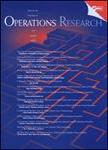版权所有:内蒙古大学图书馆 技术提供:维普资讯• 智图
内蒙古自治区呼和浩特市赛罕区大学西街235号 邮编: 010021

作者机构:Univ Chile Ind Engn Santiago 8370456 Chile MIT Sloan Sch Management Cambridge MA 02142 USA
出 版 物:《OPERATIONS RESEARCH》 (运筹学)
年 卷 期:2019年第67卷第2期
页 面:315-338页
核心收录:
学科分类:1201[管理学-管理科学与工程(可授管理学、工学学位)] 07[理学] 070104[理学-应用数学] 0701[理学-数学]
基 金:FONDECYT Complex Engineering Systems Institute [CONICYT PIA FB0816]
主 题:conjoint analysis geometric methods Bayesian models mixed-integer programming
摘 要:Questionnaires for adaptive choice-based conjoint analysis aim at minimizing some measure of the uncertainty associated with estimates of preference parameters (e.g., partworths). Bayesian approaches to conjoint analysis quantify this uncertainty with a multivariate distribution that is updated after the respondent answers. Unfortunately, this update often requires multidimensional integration, which effectively reduces the adaptive selection of questions to impractical enumeration. An alternative approach is the polyhedral method for adaptive conjoint analysis, which quantifies the uncertainty through a (convex) polyhedron. The approach has a simple geometric interpretation and allows for quick credibility-region updates and effective optimization-based heuristics for adaptive question selection. However, its performance deteriorates with high response-error rates. Available adaptations to this method do not preserve all of the geometric simplicity and interpretability of the original approach. We show how, by using normal approximations to posterior distributions, one can include response error in an approximate Bayesian approach that is as intuitive as the polyhedral approach and allows the use of effective optimization-based techniques for adaptive question selection. This ellipsoidal approach extends the effectiveness of the polyhedral approach to the high response-error setting and provides a simple geometric interpretation (from which the method derives its name) of Bayesian approaches. Our results precisely quantify the relationship between the most popular efficiency criterion and heuristic guidelines promoted in extant work. We illustrate the superiority of the ellipsoidal method through extensive numerical experiments.